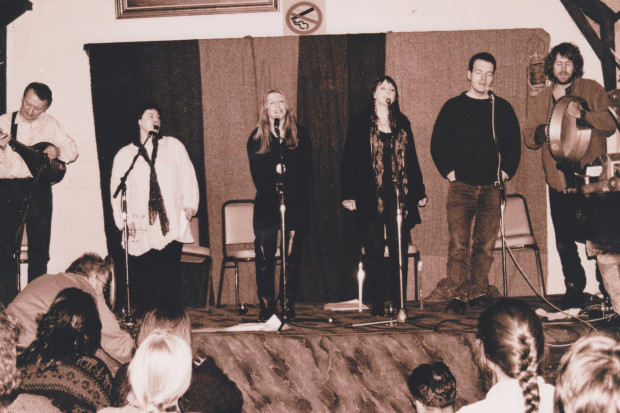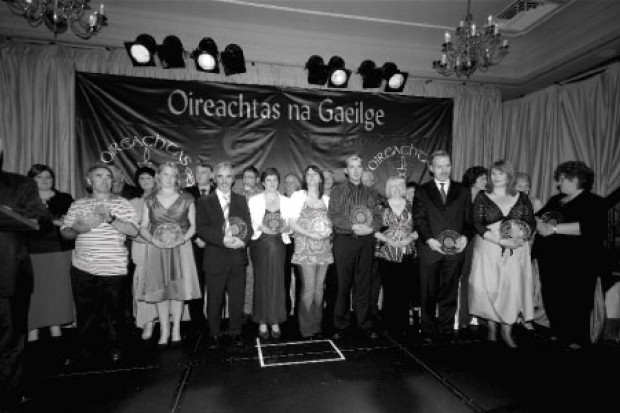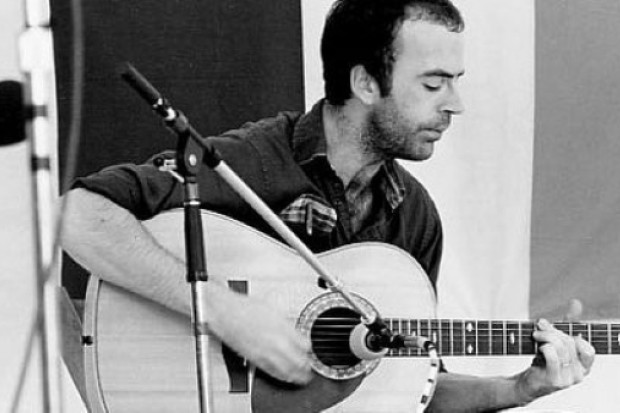Sean-nós Singing & Exoticism
Connemara Sean-nós, Josie Sheáin Jeaic (Cinq Planètes CP 03426, 2000)
Connemara Sean-nós, Sarah Ghriallais (Cinq Planètes CP 01958, 2000)
Conception, realisation, text and notes by Jean Yves Bériou
These two CDs make a welcome addition to the increasing body of unaccompanied, traditional Gaelic song available on CD. Both artists have previously recorded commercially, covering at least some of the same material and additionally much new ground. The CDs are excellently produced, presenting the material both sonically and visually in a clear and uncluttered manner. The wonderful, characterful portrait photographs of each singer, by Christian Lebon, reproduced without text on the covers arouse curiosity and prompt the question, ‘Who is this?’, inviting the interested buyer perhaps to proceed further with their inquiry, and discover more about the subjects’ music.
In all, there are twenty-one tracks on both CDs, with one, ‘Bean an Fhir Rua’ (The Red Haired Man’s Wife) common to both. Although it is the same song, in one way, both versions differ so much that they must be thought of as related but separate songs. The same may be said for the singers. Coming from the same region, their overall approach and style is similar but the effects vary greatly.
I intend to examine each CD separately first and then finish by making some observations on the assumptions about sean-nós singing which underpin the project.
Sarah Ghriallais is an acknowledged doyenne of sean-nós singing not only in Connemara but throughout Ireland and beyond. Her family tradition is rooted in the sea, her father’s boat transporting and selling turf in the Aran Islands and South-East Galway, before the advent of the lorries which gradually made the sailing boats obsolete. From a family of fine singers, she herself is active in competition performance and adjudication, taking the sean-nós grand prix, Corn Uí Riada, in 1984. Her son Micheál is also a fine singer. Sarah has made two other commercial recordings, returning once again to some of her previous material on this album. Her voice has an arresting power, tension and clarity particularly in the higher register, while her low notes are sometimes so soft as to be almost inaudible, a feature about which the accompanying notes are somewhat defensive, unnecessarily in my view . This reveals how her voice has changed over the years (it is absent in the earlier recordings) and Sarah exploits the full dramatic potential of the contrast, superbly realising some of her notes like a low, distant whistle, that invests them with a kind of desolate pathos or in Irish, cumha. Such an emotional response is the point of most of the songs since all deal with the theme of unhappy love in one way or another. Sarah sings two women’s songs, ‘Dónall Óg’ and ‘Caisleán Uí Néill’, each a circular, obsessive first person meditation on a woman’s betrayal and desertion at the hands of a callous lover. The men’s songs ‘Eileanóir na Rún’ and ‘Bean an Fhir Rua’ show a different side of the love theme, the former ascribed to Cearbhall Ó Dálaigh, an emblematic Dionysian trickster figure, who is attempting to seduce one Eileanóir Kavanagh, the latter about a man’s love for a married woman.
The theme of betrayal is developed in the more overtly political ‘Fill Fill a Rúin Ó’ and ‘Donncha Bán’, both thought to belong to the eighteenth century, put in the mouths of women, the first, according to some versions, a mother, lamenting her son’s desertion of the priesthood to become a Protestant minister. He is usually thought to have been Doiminic Ó Dónaill, from Carraig Airt in Donegal. ‘Donncha Bán’ is framed as a sister’s lament for her brother, wrongfully murdered at the hands of the Sheriff Ó Maolchróin, upon whose descendants vengeful curses are called down, while the athletic prowess and the sexual attractiveness of the dead hero are also emphasised. Both text and music in these two songs clearly recall traditions of extempore lament, caoineadh, but are made up of regular four line quatrains, as opposed to those found in Munster, which have irregular stanzas. Sarah’s interpretations of both these songs are highly impressive. The relationship between them is an interesting question which deserves to be more thoroughly researched.
‘Sagart na Cúile Báine’ seems to be a praise song for a deceased priest, with however, an erotic undercurrent also informing it. One of Raftery’s songs, ‘Máire Standún’, praises a young woman in a fulsome and elaborate way, complete with references to the heroines and goddesses of Gaelic and Classical mythology and also to some prominent authors in the latter tradition. Such verbosity is sometimes deemed to be excessive and insincere, since the convention is repeated in different poems to the point where it seems to become meaningless. This, however, is to judge such works by literary and textual standards alone. In sung performance, repetition augments the work, adding another layer of experience and meaning to it. Skilled audiences also relish their familiarity with both music and text, savouring words and music as they unfold, and anticipating with relish the emergence of what is yet to come. This is what prompts them to make short encouraging remarks to the singer between phrases and verses, which may take on a choric quality. Sarah’s hypnotic performance sustains a relatively regular pulse throughout, lulling listeners into a contemplative concentration upon the rich extravagance of the lyrics. Indeed, although it makes wonderful listening as it is, a live recording which would have included a live audience’s reactions might have worked well for this track.
‘Amhrán Mhuighinse’, a favourite song of Sarah’s, is also a powerful local anthem, highly regarded throughout the region. It represents Máire Ní Chlochartaigh’s deathbed statement, a last will and testament in song form, requesting that she be returned to her native Muighinis for burial, after a lifetime spent across the bay in Leitir Calaidh. Moreover, in an area with high emigration, the song also obliquely addresses feelings of separation and a profound sense of place in the context of human frailty and finitude. Sarah’s interpretation realises these themes with powerful understatement. ‘Amhrán Chamais’ resumes these issues once again. A locally composed song in nostalgic praise of the area, its tune is modelled on the sentimental nationalist ballad ‘The Boys from the County Mayo’, popularised by John McGettigan many years ago. However, the nationalism has disappeared in the reconstituted Gaelic text and is replaced by intense affection for locality. The places named are not towns, but an evocative catalogue of the townlands visible from the tower, a local landmark, which is very effectively apostrophised:
Céad slán leat a Tower Chamais nach mba rídheas an áit thú
D’fheicfinn as Gaillimh thú is as barr Uachtar Ard,
Camas, Glinn Chatha, Gleann Treasna is an Máimín
Gob na Trá Báine agus Cnoc Leitir Móir.
Sarah’s performance of this, the last track on the CD, is for me, a major highlight and her own pride in her locality is palpable in the loving nuance she brings to what might usually be thought of as quite a trite melody. ‘Táilliúir a’ mhagaidh’, provides something of an antidote to all this serious singing. Sarah exploits the comedy of its seemingly incongruous juxtaposition of ideal landscapes and tender erotic sentiments with satirical invective to maximum effect. One song not on the album is ‘Úna Dheas Ní Nia’, a little known song which Sarah popularised by modifying its air from an ABAB to an AABA form, thereby giving a much grander scope. However, one can’t have everything, and perhaps we can look forward to this on her next recording!
Josie Sheáin Jeaic Mac Donncha, from An Aird Thoir Carna is a justly recognised master of the sean-nós tradition. Indeed, the little peninsula of three townlands a few miles west of Carna is home to many wonderful singers, the best known being the late Joe Heaney (1919-1984). Josie is not only a great singer, but a local historian, with a deep knowledge of the oral seanchas of the area and its placenames. Moreover, he has particular skill in the placenames of the coast he frequents as an inshore fisherman. He is a frequent attendee of An tOireachtas as an adjudicator and has the rare distinction of having won the grand prix, Corn Uí Riada, three times. His style is generally unhurried and relaxed, while revealing an intense, mesmeric involvement with the texts and the music of his songs. His vocal tone may be described as a deep, nasally resonant burr, which may provide a challenge for first time listeners of sean-nós. Those who persevere, however, will be richly rewarded, and will hear a tremendous warmth radiating from the higher notes. Mostly, the songs here, like those sung by Sarah Ghriallais, reveal a preoccupation with the darker side of love, although one recounts some of the maritime adventures of Captain George O’ Malley, an eighteenth-century smuggler. The vivid images and graphic description of the ship’s difficulties in a sea storm and the crew’s appeal to the captain’s leadership make this a classic song, and Josie’s performance of it, a longer version than usual, does it great justice. Cathal Buí Mac Giolla Ghunna’s ‘Bonnán Buí’ is another classic, a self-mocking celebration of the attractions of alcohol. ‘Sail Óg Rua’, a local favourite, explores a young woman’s death with bitter recrimination. ‘An Caisideach Bán’, Tomás Ó Caiside’s confession, is a high point and wonderfully sung. Josie here uses a rising interval in the second half of the A line (falling on the word anuas in the first line), which, as far as I know, is a unique signature of his own. The singing flows majestically with unusually placed stops and pauses for breath that help sustain the attention. ‘Coinleach Ghlas an Fhómhair’ is a song that is known throughout Ireland, and is particularly associated with Donegal. This unusual version is peculiar to this small area and in recent years has become very popular. The melody, like ‘An Caisideach Bán’, is an AABA tune, which suggests that this form is not quite as rare in Connemara as has been asserted. ‘An Cumann Gearr’ is my own personal favourite. I once heard Josie on a Raidió na Gaeltachta programme, discussing this wonderful song with another Connemara singer from Leitir Móir. Each was intensely curious about the other’s version and listened with obvious interest to the other’s narrative variations, in the story of a young woman’s unhappy affair with a priest. Indeed, this song is often called ‘An Sagairtín’ (The Little Priest). The discussion made wonderful radio and showed how very much alive the song tradition is in the present, although it is often thought to belong exclusively to the past. For this CD, my wish list would include Josie’s rendition of ‘Amhrán Rinn Mhaoile’, but again, this must wait!
From the notes, it appears that more similar productions are planned in the future. We are also told that a book with the lyrics is in production, a necessity for people with a little or no knowledge of Irish – that is, most people. One aspect of the notes that disturbs me however, is the insistent exoticisation claimed for traditional Gaelic song, likening it to Flamenco, North African, Asian or Indian singing. Such a strategy is meant to be sympathetic, but it deliberately removes this kind of singing from the real, and places it in one hermetic, ahistorical, timeless, category, rendering it mysterious, eastern and non-European. The roots of such an imaginary can be traced at least to the eighteenth century and are uncritically presented here as truth more than opinion.
Such claims are highly exaggerated. Affinities of approach between various kinds of non-western singing and Irish traditional singing, while they may exist, are no proof of common origin, but this suggestion continues to be advanced, as if it somehow bestows some ineffable quality of superiority on the tradition. Writers on sean-nós singing have invoked eastern models in an attempt to show the contrast between mainstream European singing and the Gaelic style. Such ideas gained particular momentum at the turn of the twentieth century at the Gaelic League’s Oireachtas. Pre-conquest Gaelic culture was invoked as a golden age and sean-nós singing was, understandably, deemed to represent a survival from that era. Hence it was invested with much of the baggage of separatist cultural nationalism, leading to an inordinate emphasis on the ways in which it differed from European singing, considered to represent the colonial élite. The construction of this polarity is one reason why sean-nós is the way it is today. Choral and harmonised versions of songs were rejected as inauthentic and the solo, traditional singer was held up as a paragon for all to emulate. The paradox was that, regardless of effort, no amount of imitation could ever lead to the acquisition of authenticity.
The concept of ornamentation is also problematic, since it arises from a mentality informed by musical literacy. It is well known that traditional audiences did not, in the past, think in terms of base melody and ornamentation as two separate entities, but rather that they viewed performances holistically for their efficacy. A specific awareness of ornamentation, then, is a recent change in the way singers view their tradition and emanates, in my view, from the competitive arena. Likewise, an excessive preoccupation with melisma in particular has led to the neglect of other features and of styles of singing in which such tropes are not important.
Similar developments occurred in traditional music, where particular regional styles were thought to be particularly representative of a national ideal, and also in sport, where for example, a northern style of hurling, ‘commons’, was neglected in favour of a southern style, leading to its demise. Consequently, in the latter case, it is no accident that Munster hurling is, essentially, Irish hurling to this day.
A constant invocation of the exoticism of sean-nós song blinds us to the historical and sociological forces that have shaped the style over the last hundred years, the effect of Oireachtas competitions and the coming of mass media. Similarly, the acceptance of a monolithic, prescriptive model, in which for example, Connemara songs are always thought to be inferior to Munster songs because of their narrower compass, or where a singer who employs vocal dynamics such as vibrato or diminuendo (to borrow some ill-suited terminology) may be accused of pollution, is to see sean-nós as static and unchanging, which is not the case now, nor was it ever, in my view.
Such ideas are expressed in Seán Ó Riada’s Our Musical Heritage, broadcast in 1962 and published in abridged form twenty years later. This radio series was, at the time, a groundbreaking exercise in mediating traditional song and music to new and previously unsympathetic audiences and was phenomenally successful. But it was, at best, an impressionistic overview of the tradition, coming in the intensely fervent nationalistic atmosphere of the early sixties. We need new and contemporary insights into the cultural dynamics of song and music to build on this view. It cannot continue to be accepted unquestioningly as a definitive sacred text on traditional Irish music. Such mythmaking is counterproductive to the continuation and development of sean-nós singing in the twenty first century.
Like all aspects of culture, singing, whatever the style, is learned behaviour. The informal ways in which song was acquired at social gatherings before the advent of mass media are of intense interest, but cannot realistically be held up as the ‘only’ mode of transmission nowadays. Furthermore, to suggest that singers became singers without individual agency is to infer that they are not artists at all, that they have not striven to achieve the best at their chosen medium. When put in these terms, it seems clear that some of the assumptions upon which the CD notes rest need to be revised. Despite these contentions, however, Cinq Planètes is to be congratulated and, future publications from this excellent label are to be eagerly anticipated.
[spotify:https://open.spotify.com/album/4RPbDp1lSKYXraFawDOMYs]
Published on 1 January 2003
Lillis Ó Laoire retired from his post as professor of Irish at the University of Galway in 2023. He has published widely on song. His most recent book, a collection of essays written in Irish and Scottish Gaelic, edited with Philip Fogarty and Tiber Falzett, is 'Dhá Leagan Déag: Léargais Nua ar an Sean-nós' (Cló Iar-Chonnacht 2022).












